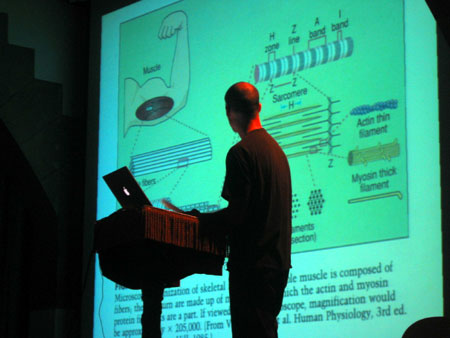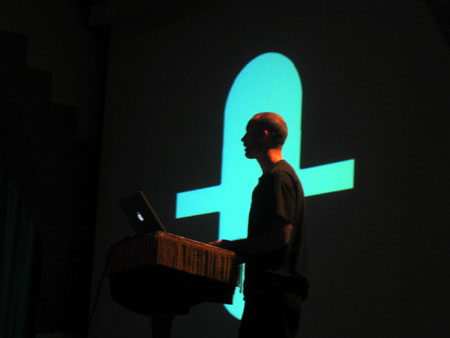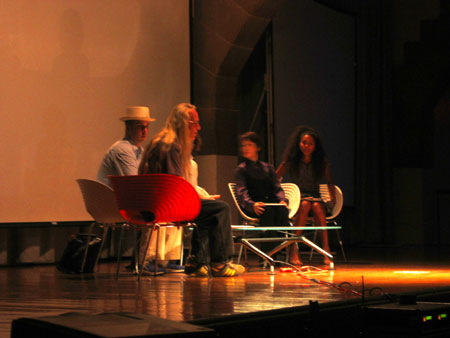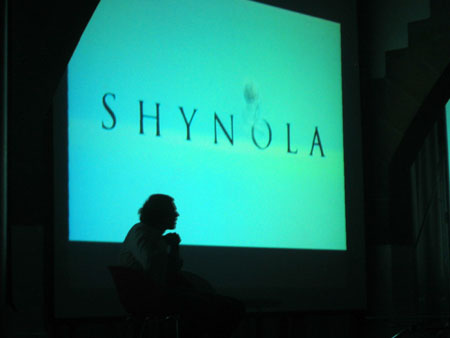 |


![]()
> archived articles
> write for core! be famous!
|
Tokion Magazine's Creativity Now Conference, New York City by Deanna Asta Dumbrys |
|||||
It takes a lot to get a group of New Yorkers to spend their Saturday in a dim basement on a gorgeous September day. Especially since mother nature seemed to have played a cruel joke on the city this summer, leaving us with few beautiful weekends. Nevertheless, there was an impressive turnout for the first annual Creativity Now Conference presented by Tokion magazine. The word “tokion” is translated from the Japanese, meaning "the sound of now" -- who better then to present a symposium bringing together top figures in art, design, fashion, photography, film, new media, publishing and marketing to discuss the cultural zeitgeist. The conference consisted of several panel discussions and was organized by Paper Magazine senior editor Carlo McCormick.
There was a good amount of chatter and excitement as the crowd gathered outside Cooper Union's Great Hall in the East Village. Inside, the mood was more low key and there were no fancy displays, snacks or freebies, just a room full of eager attendees. The stage was set for casual banter with just a coffee table and several chairs surrounding. Here's a personal review of several of my favorite panel discussions. "Independent Publishing" with Suroosh Alvi of Vice Magazine and Cecilia Dean of Visionaire Magazine discussed what it really means to call yourself an independent. Vice is one of my favorite magazines, not only because of its content, but because it is free, relying solely on advertising revenue. Visionaire, the fashion/art magazine, has no advertising, but each issue is sold for $175, a clever way around McCormick's assertion that the editorial profession is "writing on the back of ads." Vice was started in Montreal by three friends described by Alvi as "a drug addict, a pervert, and a money lager." They received some money from a welfare incentive program and started the magazine with $9,000. Describing their ambition as "punk rock capitalism," they moved to New York City because it was "more aggressive." Because they are independent and do not need to censor themselves, the magazine is known for its off-beat humor and controversial topics. They insist that they are not trying to be risque; they are just trying to be honest. Such honesty has gotten them in several lawsuits and in trouble with many advertisers. The one place where the group decided to draw the line was to refuse to run cigarette ads. This created some puzzlement during the Q&A session as to why draw the line with cigarettes--they have featured cocaine on the magazine's cover. Alvi's answer was simple: "because that's how we felt and we make our own rules. We don't need to justify them to anyone." Both Alvi and Dean contend that the creation of their magazines is an organic process; that you take it one day at a time, creating the rules as you go along. Neither thought they would have survived this long. Vice met a dot-com guy a while back whose advice they took, which landed them "a million dollars in debt," which they miraculously pulled themselves out of. Both have not only maintained what they originally set out to do but have grown into other arenas as well. Four years ago, Visionaire started V magazine, a more affordable fashion magazine. They also now have a gallery space. Vice has recently released its magazine in the UK and in Australia, formed the Vice Recording label (The Streets, The Stills), signed a TV deal with Showtime, have had five film deals, and put out a book. As most people who are at the top of their game will tell, they both claim that it was their passion and their stubbornness that led them to where they are. Dean remarked that everyone around her said "don't do it, it's the worst time!" but she replied, "it's always the worst time, just do it". Alvi shocked the audience with his candid reply during the Q&A when asked what he would do if someone wanted to buy his company. He replied, "I'd do it for the right price. Everyone has their price, man… I'm tired." The largest turnout during the two-day conference was for the multimedia artist Mathew Barney, one of the most renowned contemporary artists of our time, who is best known for his five-part film project, The Cremaster Cycle. I was thrilled when I heard that he would be speaking; it is difficult enough to see Barney's work, let alone hear him speak. I soon learned how excited the rest of New York was also as I walked up to the Great Hall to find a line around the block to get in. Carlo McCormick was particularly honored to present Barney to the conference, revealing that he once had the opportunity to interview Barney and had hoped that he would better understand his work in the end, but he was left with more questions than answers. (Some interesting Barney facts: he was captain of his high school football team, used to be a J. Crew model, went to Yale, and dates the musician Bjork.)
The elusive Barney took to the podium and began a slide show of biological charts while discussing his Drawing Restraint Project. Shy, soft-spoken and a bit nervous, Barney read from his notes in front of a video clip of two wrestling goat creatures riding in a Cadillac. Barney's delivery and charts left me feeling like I was watching a school science project rather than an artist describe his work. The Q&A session following his presentation was more enlightening. Barney revealed that he is pleased with the success of his work and glad that it can reach both the high-art world and enjoy commercial success. A woman asked how he maintains his passion for a project that lasts for several years, and challenged Barney on not sounding excited about his work. Barney replied, "even though I speak in monotone, I can assure you that I am very passionate about my work."
One of the most entertaining panels was "The Power of Pop Iconography," with Tom Sachs, Stephen ESPO Powers, and Hello Kitty creator Yuko Shimizu. The panel began with artist Powers showing clips of videos he created for the Cincinnati Children's Hospital Adolescent Care Wing. The controversial artist Tom Sachs showed us examples of his work, which were devoted to his interest with Hello Kitty (including the infamous Hello Kitty nativity scene that was once in the Christmas window of Barneys department store.) We were then introduced to the creator of Hello Kitty, Yuko Shimizu, who came in from Japan for the conference and who does not speak a lick of English. Yuko possessed the same sweet, innocent, "cute" characteristics as Hello Kitty. The discussion focused on the use of art as propaganda. Sachs tried to explain his obsession with Hello Kitty, stating that when he was really broke, HK was one of the only things he could buy that made him really happy. "It was cute, cheep, and well made." Yuko had never seen Sachs's work and was both flattered and shocked by the use of HK as his medium. Yuko told the story of how HK was created. She was approached by the Japanese toy company Sanrio to create a fun character to help sell products. Yuko created a series of several characters, including a bear and a dog, but the cat character really took off and outsold all the others. The Hello Kitty industry was born. Yuko herself does not understand why this character has such mass appeal. The topic of gender in art was brought up, and Carlo asked Yuko if she had ever thought of creating a character like HK for boys. Yuko looked a little puzzled and began giggling. She replied through her translator, "I have never thought of making a HK version for a boy because I am a girl…sorry!" Her answer was followed by laughter and cheers from the audience. This enthusiasm for HK continued until it began to dominate the discussion panel. Yuko also introduced a new character she has created, a variation on the HK theme and not yet out in Japan. During the Q&A session, Yuko brought out big bags of goodies featuring her new character and announced that if you asked her a question you would get a free toy. Sachs was overjoyed when Yuko handed him a plastic mask of the new character. The audience was filled with the raised hands of people competing to ask Yuko a question. Someone asked why HK didn't have a mouth, and she replied, "I couldn't make a mouth that was cute enough, so I left it off." Again her answer was followed by clapping and chuckles.
As HK dominated the Q&A by greedy audience members, half the audience started to shout, "Let someone else on the panel speak!" When someone finally asked a question for ESPO, there was cheering from the crowd. At the close of the Q&A, the stage was flooded by people trying to get their free toys. I sat in my seat and watched the scene in bewilderment. I couldn't believe the excitement the cutesy stuffed animals induced. I found myself with conflicting feelings, because I was both envious of the people with the HK stuff and put off by their behavior. Before this, I had never desired Hello Kitty. But sparked by all the hype, it occurred to me that this is exactly how a pop icon is created! My confused feelings for Hello Kitty were no different than my feelings for Brittany Spears. In the end, the panel on "The Power of Pop Iconography" unintentionally created a great illustration on its own theme. Since the conference, I cannot help but notice Hello Kitty paraphernalia everywhere I go, and the other day I almost bought a HK coin purse. Damn those pop stars! The seminar ended with a casual presentation by the English music video animator/illustrators, Shynola. Shynola recently won a CAD (a music industry award in the UK) and showed us recent music videos for The Rapture, Blur, Jamiroquai, Athlete, and Grooverider featuring Cypress Hill. Two of the four members for Shynola were present, and spoke candidly about their experience with the music industry. They spoke of their frustration with the state of music videos today and their lack of creativity. They revealed that they often make a video first and then try to find a group to use it for a song. Their videos are a far cry from most glitzy, overproduced videos. Their work consists of simple animations and illustrations, and this simplicity is refreshing. Shynola say that they are trying to find hip-hop clients and want to lure them away from all the homogenous videos full of champagne and booty dancers. Shynola ended by telling us that famous musicians are all pretty dull and aren't any different from any of us. Thanks Shynola, for the reaffirmation in a room where Hello Kitty has more power than a rock star!
Couldn't make it to the conference? Don't fret; Tokion's November/December issue, #38, will be devoted to The Creativity Now Conference. |
|||||
|
|||||




